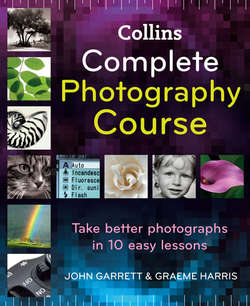Читать книгу Collins Complete Photography Course - John Garrett, Graeme Harris - Страница 26
Lenses
ОглавлениеThe primary function of a lens is to focus the image onto the film or sensor. It also controls the angle of view and houses the aperture diaphragm.
Lenses come with fixed focal lengths (known as prime lenses) or as zoom lenses. The latter are designed to provide many focal lengths in one lens, which reduces the amount of equipment that a photographer has to carry on location.
The advantage of prime lenses is that they have the largest apertures, allowing you to work in lower light levels without a tripod and to choose a shallower depth of field, which is useful in selective focus imagery. They are also still the best in terms of sharpness and minimum distortion.
Within these two categories there is a further choice between digital (D) and analogue lenses. The former are dedicated to digital cameras and will not work with film cameras; however, the latter can be used with both film and digital cameras, which means that if you are changing from film to digital you won’t have to go to the expense of buying new lenses.
Perspective correction lenses are used for eliminating the distortion that occurs when you photograph a tall building from a low viewpoint. The front of the lens can be moved up, down and sideways while the camera remains on the same plane. These lenses are mainly used by photographers specializing in architecture.
Focal lengths
While the sensors of DSLR cameras vary, they are approximately two-thirds the size of a 35mm film frame. This means that lenses are effectively increased in focal length by 1.5x, so that, for example, a 50mm lens will become a 75mm lens on a digital camera and a 200mm lens has the effect that a 300mm lens would have on film.
This means that there is an advantage at the telephoto end of focal lengths but a disadvantage in wide-angle lenses because a 24mm lens on a film camera is only about 36mm on a digital camera. To get a really wide-angle effect you need a 12mm or 14mm lens for digital, of which there are now plenty available.
Lenses range from an 8mm fisheye right up to 2000mm. There are also some very specialized lenses such as the perspective control lens and macro lens. Today, zoom lenses are used almost universally by most photographers, although some still prefer to work with fixed focal lengths.
You’ll find that just two lenses, a wide-angle zoom and a medium to telephoto zoom, will cover most situations. Indeed, the majority of people never use anything other than a zoom because cameras are usually sold with a zoom lens included, and they are also the easiest, lightest way to go. However, if you are interested in close-up photography you may want to consider using a fixed focal length macro lens as the quality is superior to that of the macro setting on the zoom lens.
Macro lenses are the sharpest you can buy. Most are about 55-60mm focal length, used with film; their focal length is effectively increased by 50 per cent on a digital camera. They are relatively inexpensive and you will probably be able to find a secondhand one at a good price on eBay.
Photographers keep to their favourite lenses over many years. It is often not so much that there is anything particularly special about that lens, but that it suits the way they see the world and the type of work they like to do.
Good-quality lenses, especially those with large apertures, can be very expensive. However, independent lens manufacturers such Sigma and Tamron make high-quality lenses for most DSLRs at about half the price of the camera manufacturers’ lenses.
Focusing modes
Your lens is focused via three modes that are selected from a switch on the camera body: S, C and M.
• S Single auto will automatically focus on the object that you point the camera at when you push the shutter button halfway down. It will fix that focus until you release the button or take a picture.
Reflex telephoto lenses have an internal mirror system and fixed aperture. Their creative characteristic is that they turn out-of-focus highlights into doughnut-like shapes.
A recent addition to some lenses is vibration reduction (VR), which allows you to shoot with lower shutter speeds and still get a sharp image. VR may be incorporated in the camera body instead of the lens.
• C In continuous auto, the camera will follow focus on a moving object when you keep your finger halfway down on the shutter button.
• M In manual mode the camera is focused by using the focusing ring on the lens. The focus indicator dot will light up when you are in focus.
Most DSLRs give you a choice of where to place your point of focus in the viewfinder. This could be a single point that you can move around the viewfinder and place where your subject is. Alternatively, you can group a number of the points together to cover a larger focus area in the viewfinder. This varies with different camera models.
Focusing modes
Focus lock
You will also have a focus lock on the camera. This may be a question of pressing the shutter release button halfway down, or there may be a separate button.
